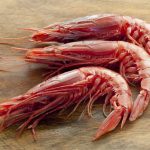 Term used to describe a large shrimp.
Term used to describe a large shrimp.
The prawn, a crustacean similar to a shrimp, is typically more sizable and possesses a refined taste profile in contrast to its American counterpart. Prawns are more abundant in Europe than in the United States. Similar to shrimps, prawns are initially pale in color when captured, but are subjected to boiling before retailing, resulting in the shell transforming into a reddish or pinkish hue.
Prawns bear a resemblance to sizable shrimp, showcasing a more slender physique and elongated appendages. Upon being captured, their natural hue takes on a grayish-brown shade, yet once subjected to the boiling process, they undergo a remarkable transformation, adorning a vivid pink complexion. This metamorphosis renders them an aesthetically pleasing addition to salads, entrees, or appetizers, lending a touch of visual allure. Moreover, prawns possess an exquisite taste and serve as a delectable stuffing option for white fish, omelets, or delicate pastry shells, among other culinary possibilities. These crustaceans find their application in various gastronomic preparations, including sauces, gratinated creations, and exotically spiced dishes. Furthermore, they often take center stage in tantalizing appetizer cocktails. It is worth noting that the majority of prawns available in the market are sold in a frozen state. Interestingly, the term “prawn” is frequently misused to designate large shrimp that do not belong to the prawn family, both within culinary establishments and in the marketplace. In the United States, prawn varieties can exclusively be found in the southern coastal waters spanning from North Carolina to Texas, while some are also cultivated in the idyllic island of Hawaii.
